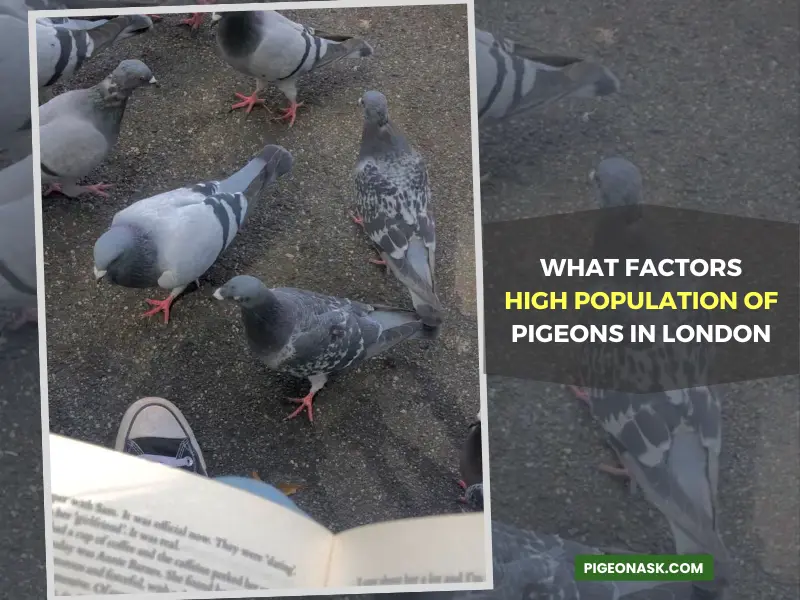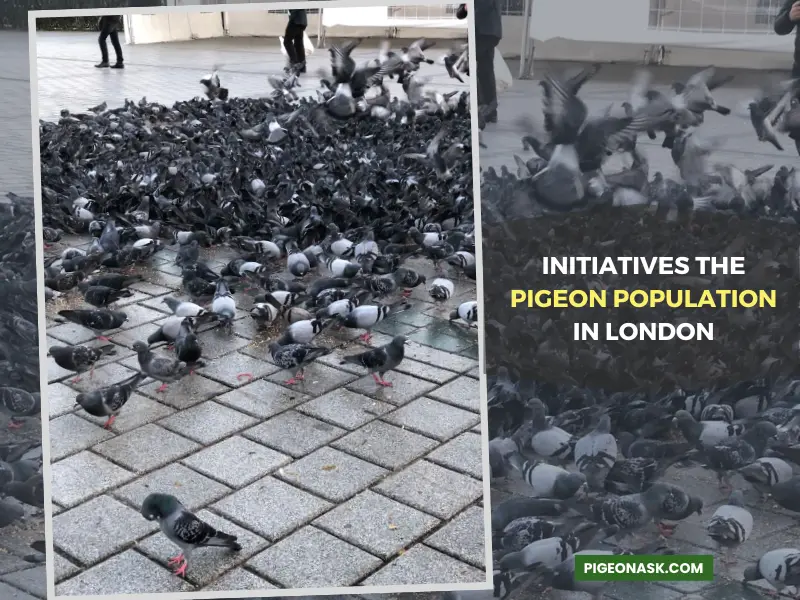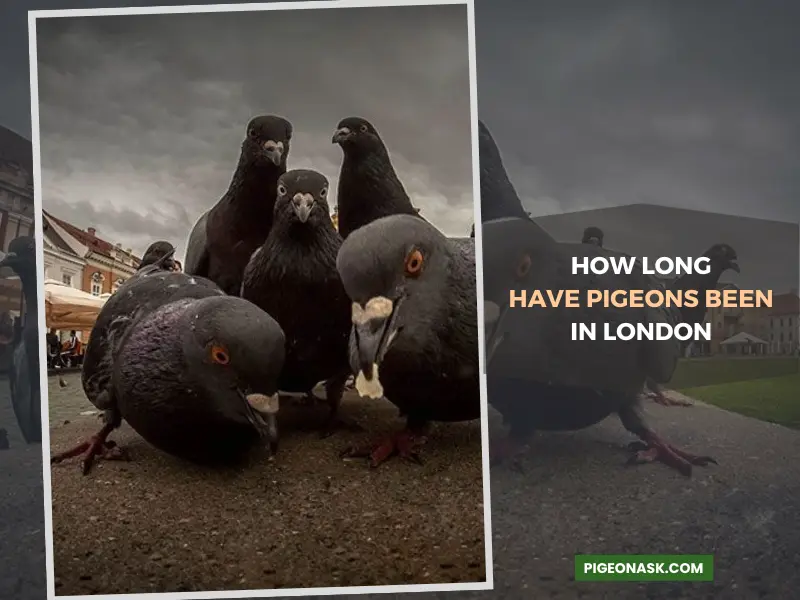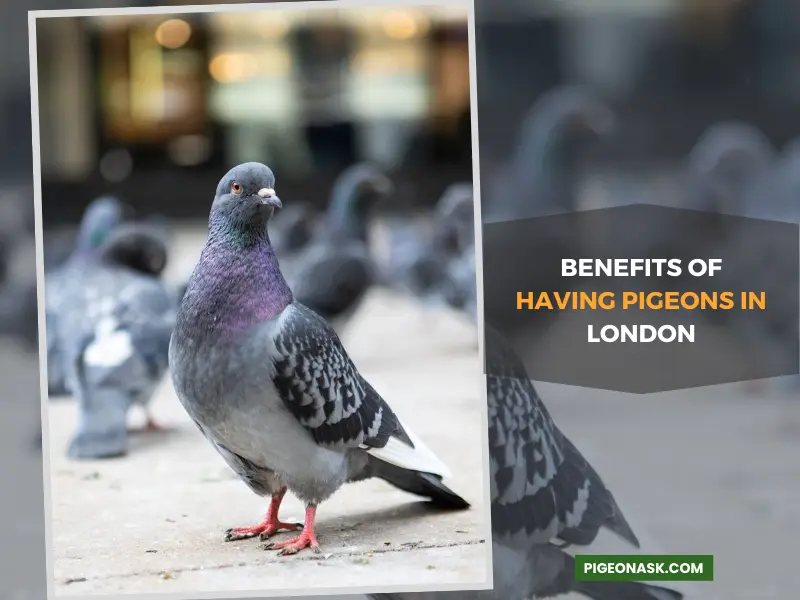Why Are There So Many Pigeons In London
Estimates say there is 1 pigeon for every 3 people in London. These birds have become synonymous with the London scenery. However, their large numbers can also have some menacing effects.
But why are there so many pigeons in London? The primary reason is human tolerance. Londoners had adored and fed these pigeons for a long time. Pigeons’ reproduction rate, nesting opportunities and lack of natural predators in the city are also contributing factors.
If you are a Londoner or a frequent visitor to the city, you must have been overwhelmed by the abundance of pigeons. Dealing with their droppings isn’t a pleasant experience for anyone. Learn in more detail about the situation.
Looking for more articles about pigeon blog:
What Factors Contribute to the High Population of Pigeons in London?
The major contributing factors to the high population of any species are the availability of food and the absence of predators.
And the same applies to London pigeons. The city’s buildings also provide the perfect nesting opportunities for the birds.

01. Londoners Adore Pigeons
For most of London’s history, people didn’t regard pigeons as pest birds. Instead, they were an integral part of the London scenery.
As a result, people got in the habit of living with them. For a long time, they didn’t even consider managing the pigeon population. Hunting or reducing their population would’ve been considered cruel back then.
You couldn’t imagine famous spots like Trafalgar Square, Cavendish Square, or Kilburn High Road without the fluttering flocks of pigeons.
Until the government bans came, feeding the feral pigeons on these spots had been a favorite pastime for London folks and tourists alike. Many people used to make a living out of selling pigeon feed at those parks and squares.
In short, the Londoners loved the birds, overfed them good corn, and didn’t take any steps to manage their numbers initially. And those are the main reasons for so many pigeons in the city today.
02. Food Availability
Even if people stop feeding them, feral urban pigeons have no trouble finding food in the city. Pigeons can survive in a variety of foods and have excellent foraging abilities. They can find their food from the city’s litter and waste.
Pigeons mainly prefer grains, seeds, and fruits. However, urban pigeons can also satisfy their nutritional needs with foods people throw away, such as meat, bread, cake, and cheese.
There are nine million residents in the London city. If everyone threw away even minor portions of their food, it would be enough to feed the three million pigeons in the city.
03. Ideal Nesting Sites
Pigeon’s natural tendency is to nest and roost on cliffs and rocks. London’s numerous tall buildings and structures resemble them, thus providing the ideal nesting site for feral pigeons.
In London, pigeons can find perfect nesting opportunities on roofs, old chimneys, statues, bridges, and monuments. For pigeons, there is little difference between the ledges or balconies of buildings and the mountain cliffs regarding nesting.
Pigeon’s nesting habits play an important role in the high number of pigeon population. They are pretty loyal to their sports. If a pigeon has made a home in a city, it and its subsequent generations are not going anywhere unless forced to.
Also, animal rights organizations in the UK, such as RSPCA, encourage people not to disturb the pigeons nesting in their buildings. As a result, millions of pigeons have found peaceful nests in London for centuries.
04. Reproductive Rates
The massive number of feral pigeons in London has much to do with the birds’ high reproduction rates.
Usually, pigeons breed year-round. You can expect one healthy pigeon to produce up to a dozen squabs (baby pigeons) annually. Keep in mind the lifespan of pigeons in the wild is 15 years.
London provides all the ideal reproductive conditions for pigeons. For instance, the mild climate of the city and the abundance of food and water encourage the pigeons to breed more.
05. Lack of Natural Predators
In the wild, the pigeon population would never get out of hand. Hawks, owls, foxes, and other creatures prey on pigeons and squabs. Thus keeping their numbers under control.
However, unlike pigeons, most of their predators can’t adapt to the urban scenery. Also, people are more likely to be alarmed about a fox or hawk in their backyard than a bunch of pigeons.
This means the city people have actively fended off the natural predators of these birds. As a result, there is nothing preventing pigeons from living and to keep increasing in numbers.
Are There Any Initiatives in Place to Manage the Pigeon Population in London?
London administration started managing the pigeon population in the early 2000s. The pigeons’ droppings had been destroying the beauty of the city’s buildings and monuments. Plus, they were also spreading diseases.

Some significant initiatives London took to manage their pigeon population are the pigeon feeding ban, hawk patrol, and the Heritage Wardens.
The Pigeon Feeding Ban at Trafalgar Square
Trafalgar Square is one of the most popular and vital spots in London. Besides people, it attracts vast numbers of pigeons too. Feeding these birds had been a favorite activity for visitors to the square.
However, this mindless pigeon feeding at Trafalgar Square significantly increased the bird population in that area. The square became ridden with pigeons dropping, increasing the incidence of fungal and parasitic infections.
So, in 2000, the Mayor of London banned selling pigeon feeds in the square. The Mayor also discouraged the visitors of the square from feeding pigeons in general.
And the Mayor’s decision was met with protests from the RSPCA. Eventually, the group obtained permission to feed the pigeons once a day at 7:30 a.m.
RSPCA also introduced a pigeon feed that was nutritious yet brought down the birds’ reproduction rates.
However, the Mayor’s office withdrew this permission, and finally, the Pigeon Feeding Ban at Trafalgar Square was enforced with a bye-law.
According to this law, unauthorized Londoners and tourists are prohibited from feeding the birds. Anyone caught in the act might face fines of up to £500. Also, a part of this initiative was to educate people on how pigeons have become pests.
The Pigeon Feeding Ban at Trafalgar Square was very successful. Within a year, the pigeon population in that area reduced from 4000 to less than 1000. Many other public squares and parks in London also started taking the same approach.
Hawk patrol
A major initiative for controlling the London pigeon problem is Hawk Patrol.
Famous spots like Trafalgar Square, Parliament Square, City Hall, Westminster Abbey, and St Paul’s Cathedral have implemented methods to control pigeon populations.
The method uses a trained hawk or falcon to scare away the pigeons. A professional handler is in charge of the hawk. On his signal, the hawk would swoop down on the pigeons and return to the handler again.
It’s the most humane yet effective way of dealing with the pigeon problem since you are not killing the birds and only scaring them away. Plus, you don’t have to use any harmful chemicals or devices.
Hawk patrol discourages pigeons from flocking, nesting, or roosting in a particular area. The method is used regularly, for instance, weekly or half-monthly.
Depending on the area and pigeons’ numbers, it might be done more frequently.
Heritage Wardens
The Heritage Wardens are a staff group of the Greater London Authority. Their job is to preserve the beauty of Trafalgar Square. Through various proactive actions, they have successfully reduced the menacing pigeon population at the square.
For instance, the wardens would collect any food or pigeon feed the visitors at the square leaves for the pigeons. Thus reducing the food availability for the birds.
They would also use sirens and horns to scare away flocking pigeons.
How Does the Presence of Pigeons Affect the London Ecosystem?
Pigeons harm the London ecosystem in three major ways. First, their droppings can destroy the beauty of city structures like statues and monuments.

Second, they are the cause of various infectious diseases. Some people also have allergies to pigeon feathers. Lastly, their nests can clog the city’s drainage systems.
01. Pigeon Droppings
First of all, pigeon droppings are gross. It’s a nasty experience when the birds drop these loads on your car window or, worse, your head. They also make the buildings, monuments, and statues dirty and unpleasant.
Apart from the dirtiness and grossing people out, pigeon droppings also have corrosive properties. Which means they will stain and erode the stone, metal, and concrete surfaces of the city’s structures.
The damage can accumulate to costly repairs. According to some estimations, London has to spend around four million dollars to clean off the pigeon droppings from their public buildings.
02. Clogging the Drains
Urban pigeons use straws, twigs, plastic, clothes, and similar items to fortify their nest. They also shed their feathers during the molding seasons. And they do all this on the high edges of the tall buildings.
Usually, urban buildings have gutters or other drainage systems to let the rainwater escape. The pigeon nests and feathers can block these gutters and interfere with the draining process.
03. Spreading Diseases
Pigeons dropping cause the spread of various bacterial, fungal, and viral diseases. These include histoplasmosis, cryptococcosis, psittacosis, avian flu, etc.
The microorganisms of these diseases are present in pigeon droppings. These droppings turn into fine dust when they dry up and enter the human body through inhalation.
You might also be one of those people who have an allergic reaction to pigeon feathers. Plus, the birds are hosts for lice, ticks, and mites. And those parasites can find their way into your home when you pet a feral pigeon at the park.
When the pigeon population in a city is at normal levels, the birds don’t pose a health risk for the dwellers. However, in London, where the birds’ population is out of control, pigeon-related diseases can be a very real thing.
How Long Have Pigeons Been in London?
Pigeons have been in London for centuries. If you only consider the history of modern London (18-19th century), pigeons have been here from the beginning.
People have been feeding birds at Trafalgar Square from as early as the 1800s.
Presently, only one type of pigeon dominates London- the feral pigeon. They have descended from multiple pigeon types. Most experts agree that the feral pigeons from London are the descendants of the Rock Dove.

Early inhabitants of London domesticated the Rock Dove and created the Homing Pigeons. These pigeons were strong flyers and had the special ability to find and return to their homes after traveling miles.
The Homing Pigeon’s abilities made them excellent messengers during the world wars. They were also the perfect choice to produce racing breeds. And, of course, people kept these pigeons as beloved pets.
Some pigeons always chose not to return home or flee. As they didn’t leave the city and became wild urban pigeons. Eventually, after years of interbreeding, London’s current Feral Pigeon population emerged.
What Types of Pigeons are in London?
London boasts two main pigeon types:
Feral Pigeons: These bold scavengers rule the city center. They’re descendants of rock doves and thrive on the urban buzz. Feral pigeons are known for their characteristic cooing. These are often seen in parks and squares
Wood Pigeons: These larger pigeons prefer a more natural habitat. They like quieter areas like gardens and parks. Unlike Feral pigeons, they’re picky eaters. They opt for leaves, berries, and fruits found in parks and gardens.
Feral pigeons dominate the city, while wood pigeons seek tranquility. These contrasting behaviors and habitats showcase their unique adaptations to different parts of London.
What Are the Benefits of Having Pigeons in London?
This is in no way an anti-pigeon discussion. We have only tried to get to the bottom of London’s menacing pigeon population problem.

A controlled pigeon population can be beneficial for the city in many ways –
- Pigeons are beautiful creatures and watching them scurrying around can be an excellent time.
- Controlled Pigeon feeding can teach people about loving and bonding with animals.
- Moderate amounts of Pigeon Droppings can act as a fertilizer for the city’s plants.
Is it illegal to feed London’s pigeons?
While feeding pigeons has long been a tradition in London, it’s essential to be aware of the current regulations.
In specific areas, feeding pigeons is strictly prohibited. This includes Trafalgar Square and other designated zones. This ban, implemented in 2003, aims to address concerns related to the rapid growth of the pigeon population, which led to:
- Increased mess and property damage from droppings
- Potential public health risks
Violating this regulation in these restricted areas can result in a fine of £500 and, in rare cases, prosecution.
Pigeon feeding is generally not illegal outside these designated zones. But it’s always wise to check local regulations before offering them food. Additionally, other considerations include:
- The potential for attracting nuisance flocks and unwanted attention from the pigeons.
- The abundance of readily available food sources in urban environments, eliminating their need for human intervention.
Therefore, enjoying the company of these feathered residents of London is best done through observation, not feeding.
Conclusion
Hopefully, you understand why are there so many pigeons in London. The city people used to see them as a public treasure, not a pest.
But since realizing the situation, Londoners have been managing their city’s pigeon problem in the most humane ways possible. Other cities that are facing the same problems can learn much from London.
That’s all for this discussion. Don’t hesitate to share this information with the rest of the internet. For more content like this, follow our Facebook, X, and Pinterest pages.
References:
- https://londonist.com/2016/07/where-did-trafalgar-square-s-pigeons-come-from
- https://www.standard.co.uk/esmagazine/why-we-should-celebrate-london-s-pigeons-a3204736.html
- https://www.channelnewsasia.com/singapore/pigeon-population-keep-growing-unless-people-stop-feeding-924686
- https://www.rspca.org.uk/adviceandwelfare/wildlife/birds/nests
- https://www.theguardian.com/politics/2006/sep/29/uk.localgovernment
